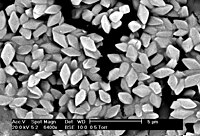
Photo from wikipedia
Bacillus cereus is a major food-borne bacterial pathogen in the world, which can cause diarrhea and emetic syndrome. This study aimed to reveal the quantitative prevalence of B. cereus in… Click to show full abstract
Bacillus cereus is a major food-borne bacterial pathogen in the world, which can cause diarrhea and emetic syndrome. This study aimed to reveal the quantitative prevalence of B. cereus in ready-to-eat (RTE) rice products in Eastern China and to gain essential information on the characteristics of B. cereus isolates. A total of 91 out of the 1071 samples were positive for B. cereus. The contamination level of B. cereus in 0.5 % of RTE rice product samples outnumbered 103 CFU/g. The number of B. cereus attained 105−106 CFU/g in one sample. The distribution patterns of virulence genes in B. cereus isolates were identified. 84.6% of the B. cereus isolates had at least one enterotoxin or emetic toxin gene. The predominant pattern was XXV. 9.9% of isolates belonged to it and possessed one enterotoxin gene entFM. The occurrence rate of hblACD and nheABC was 36.3% and 47.3%, respectively. Antimicrobial susceptibility tests revealed a high resistance rate toward penicillin, and 23.1% of the isolates were multi-drug resistant. B. cereus isolates were genotyped by using ERIC-PCR. 89 genotypes were determined. The Hunter Gaston Discriminatory Index (HGDI) attained 0.9995. Relationships analysis revealed that Group A B. cereus isolates tended to carry hblA, hblC, hblD, nheA, nheB, and show resistance to penicillin/trimethoprim/sulfamethoxazole. This study was useful for updating the knowledge of the contamination status of B. cereus in RTE rice products in China.
Journal Title: Frontiers in Microbiology
Year Published: 2022
Link to full text (if available)
Share on Social Media: Sign Up to like & get
recommendations!